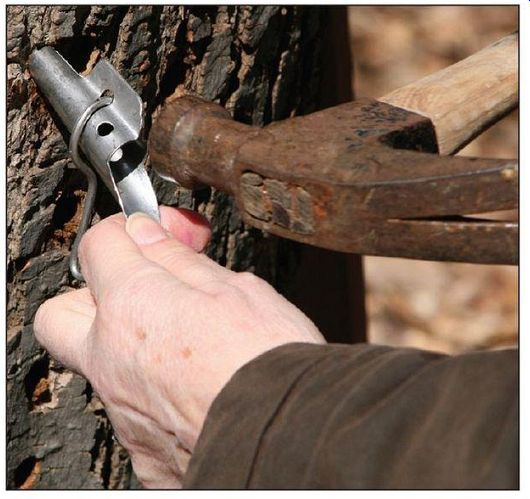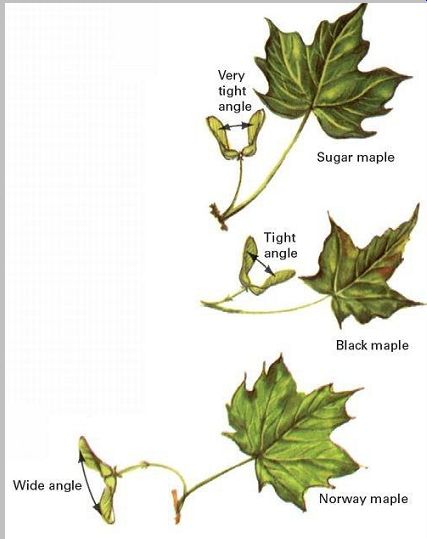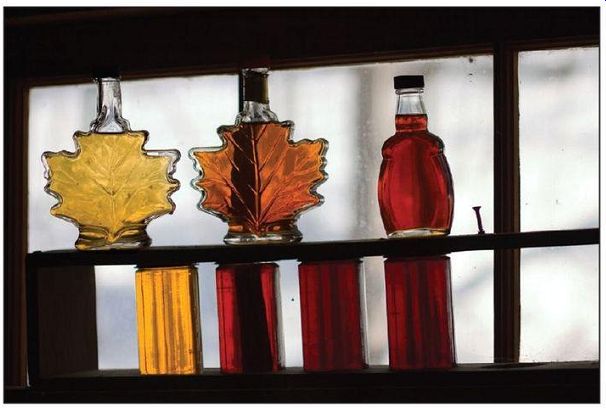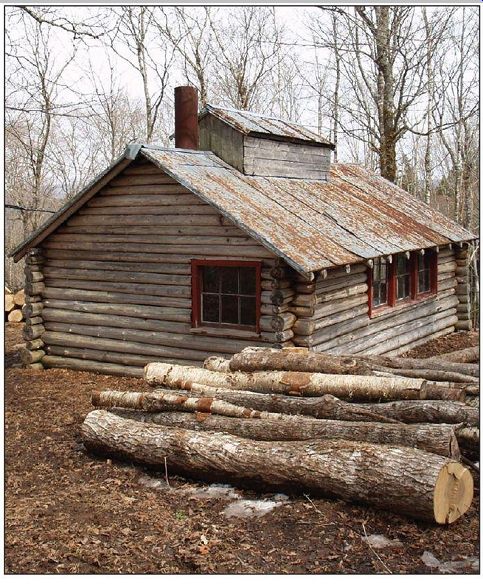Two Quarts of Syrup From One Maple
The art of making maple syrup and maple sugar is uniquely American. In the days before the coming of the white man, Indians of the Northeast would cut slashes in the bark of the sugar maple, collect the sap that ran off, and boil it down in a hollowed-out cooking log by continually adding heated rocks. Early settlers in the New World soon learned the skill and improved on the Indian system by using iron drill bits to tap the trees and copper buckets to evaporate the sap into syrup and sugar. Small-scale family sugaring has long been an American tradition, and recently the rising cost of syrup has provided additional incentive for the backyard sugarer.
A good maple will yield 15 to 20 gallons of sap during a single sugaring season-enough to make about 2 quarts of pure, preservative-free maple syrup.
The Tools and Techniques of Tapping
The larger the diameter of the trunk and the greater the spread of limbs at the crown, the more sap a healthy tree will yield. Trees with trunks smaller than 10 inches should not be tapped; the yield will be low and the tree may be injured. There are several sap flows, but by far the best time to tap is in late winter or early spring before the buds open: sugar content is high, flavor is at its peak, and the cool nights inhibit bacterial action.
Tap holes can be drilled on any side of the tree, although production from the south side is generally greater early in the season. Drill 2 to 3 inches into the sapwood-no deeper. Greater penetration will not produce much more sap and may injure the tree. Use a brace and bit and drill at a slight upward angle (10° to 20°). The hole diameter should be less than that of the spout, or spile, to be inserted: 7/16 inch for a standard 1/2-inch spout. Tap holes can be located anywhere from 2 to 6 feet above the ground.
A big tree (over 2 feet in diameter) can be tapped in four or more spots. One or two taps is safer for a small tree. A new hole in a tree that has been tapped previously should be about 6 inches from tap scars.

------- Spile is gently driven into hold at slight upward angle.
Gray, somewhat scaly bark is typical of black maple.
As soon as a hole is drilled, the spile should be inserted.
Do this by tapping the spile rather than hammering it; if excessive force is used, the bark may split, damaging the tree and creating a leaky tap. Metal spiles, tapered to fit snugly and with built-in bucket hooks, are widely available in rural areas, or you can make your own spiles by hollowing out 4-inch lengths of sumac with a heated awl or other reaming instrument. (Be sure to select only red berried sumacs; white or light green berries indicate a poison sumac.) If you use a wooden spout, hammer a nail in the tree above it to support the sap bucket.
Collect the sap in covered containers. Galvanized 2-to 3 gallon buckets are traditional, but plastic 1-gallon milk containers serve well, and their narrow necks do away with the need for a cover. Clean the container thoroughly and suspend it beneath the spile by a wire or strong string. You can store sap outdoors in large containers, such as clean plastic trash cans, for up to three days as long as the weather remains cold. A warming trend is a signal to process the sap more rapidly and to remove the spiles. The tree will heal by midsummer.
Sap Into Syrup
As soon as you have collected enough sap to make an appreciable amount of syrup, you should begin boiling it down. Almost any outdoor heating device will do, from a simple bonfire to a commercial evaporator working on bottled gas. Kerosene stoves, gasoline-fired camp stoves, and old coal-burning ranges have all been used successfully. Wood is the fuel of choice, however, since it is safe, inexpensive, and there is less risk of spoiling the taste of the syrup. If you have an outdoor barbecue pit, you can do your evaporating there. If not, you can construct a temporary evaporator out of cinder blocks. Do not boil sap down inside your house, however. The result will be a sticky deposit of sugar on walls, furniture, and floors. Whatever the fuel used, shield the evaporating device from the wind to conserve fuel.
Boiling down sap takes a lot of fuel, so be sure to have plenty on hand. If you are using wood, you will need about a quarter cord for every 4 gallons of syrup produced. The evaporator pan should be clean, have a large heating surface, and hold at least a gallon of sap, preferably more.
A big roasting pan will do for small-scale sugaring. You will also need a stirring spoon, a candy thermometer, a 1- or 2 gallon "finishing" pot, and a kitchen strainer. In addition, have some heavy felt cloth or paper toweling on hand to filter the finished syrup.
Fill the evaporator pan about half full of sap and bring the sap to a boil over the fire. Unprocessed sap is mostly water, and its boiling point is the same as that of water (212°F at sea level, 1°F lower for each 550 feet of elevation). As the water vapor is driven off, the boiling point slowly rises. When the temperature reaches 7°F above the boiling point of water, the syrup is done.
Stalking the sugar tree
For sugaring, the sugar maple and black maple are best, with the Norway maple a close third. Other maples can be used, but syrup production is lower.
The sugar maple's ash-gray bark is often broken into hard flakes. The bark of the black maple is smooth and gray when young; scaly, furrowed, and darker when old. The range of both trees extends from New England west to Minnesota, north into Canada, and south to Tennessee. identify trees in summer and mark them for spring tapping.

-------------
During the course of the evaporation process, skim off surface froth with the kitchen strainer. Whenever the sap gets low in the pan, add more to prevent burning or scorching. As the syrup nears the ready stage, it tends to boil over, so most sugarers finish the syrup on a stove whose heat can be easily controlled. When the syrup is 6°F above the boiling point of water, it is ready for finishing.
Remove the evaporator pan from the fire and pour the syrup into the finishing pot, at the same time filtering it through felt cloth or paper towels placed in the strainer. (Be extremely careful when handling the pan; hot sap will stick to the skin, producing severe burns.) The purpose of filtering is to remove any impurities, particularly the granular calcium compound known as sugar sand, which is found in all maple sap. Once the syrup is finished, it should be bottled immediately while still hot. Some sugarers filter the syrup a second time, as it is being poured into the storage jars, to remove any traces of sugar sand that may remain.
Storing and Processing Maple Syrup and Sugar
Pure maple syrup can be stored for extended periods of time without the addition of artificial preservatives. The most practical method for long-term storage is by canning in airtight glass, plastic, or metal containers. Of the three, glass containers, such as mason jars, are best because they do not rust, do not affect the flavor as some plastics do, and allow the syrup to be inspected without opening the container. Pour the hot syrup (it must be at least 180°F) directly from the finishing pot into the containers, seal the containers, and let the syrup cool slowly to avoid risk of contamination. Store the bottles of syrup in a cool, dark place such as a basement or pantry.

---------------- Highest grade syrup (left) is pale and delicately flavored;
it is made from clear sap that has been boiled down quickly. Home sugarers,
how ever, often prefer the richer tasting, darker syrup.
Syrup will also keep in non-airtight containers for several months provided they are refrigerated. It can even be frozen, but this may result in loss of flavor and will also cause the syrup to crystallize and separate.
Soft maple sugar and hard maple sugar will both stay fresh for long periods of time if stored in moisture-proof containers and protected from contaminants. To make soft maple sugar, cook maple syrup in a pot to about 30°F hotter than boiling water, let it cool to 155°F, and stir until it becomes thick and viscous. Then pour into molds. Hard sugar is made by bringing syrup to 33°F above boiling water, cooling to 150°F, and stirring until crystals form.
While you are sugaring, you can also enjoy an old fashioned treat simply by pouring some of the hot syrup (about 230°F) on snow or crushed ice. The result is a taffylike confection known as Jack wax.

Sugar shack in Nova Scotia, Canada is well-ventilated to allow steam from
evaporator to escape. As the sap cooks, it is checked periodically with a candy
thermometer.
When temperature reaches 7ºF above the boiling point of water, syrup is ready. About 1/4 cord of dry hardwood will boil down 200 gal. of sap.
===